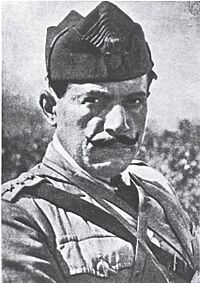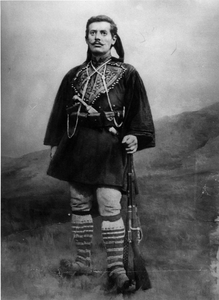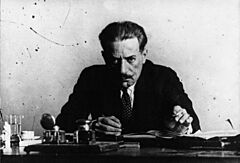Georgios Kondylis facts for kids
Quick facts for kids
Georgios Kondylis
|
|
|---|---|
| Γεώργιος Κονδύλης | |

Georgios Kondylis c. 1919
|
|
| Regent of Greece | |
| In office 10 October – 25 November 1935 |
|
| Prime Minister | Himself |
| Preceded by | Alexandros Zaimis (as President of Greece) |
| Succeeded by | George II (as King of the Hellenes) |
| Prime Minister of Greece | |
| In office 10 October – 30 November 1935 |
|
| Monarch | George II (Nov 1935) |
| Regent | Himself (Oct - Nov 1935) |
| Preceded by | Panagis Tsaldaris |
| Succeeded by | Konstantinos Demertzis |
| In office 23 August – 4 December 1926 |
|
| President | Pavlos Kountouriotis |
| Preceded by | Athanasios Eftaxias |
| Succeeded by | Alexandros Zaimis |
| Deputy Prime Minister of Greece | |
| In office 5 April – 10 October 1935 |
|
| President | Alexandros Zaimis |
| Prime Minister | Panagis Tsaldaris |
| Preceded by | Andreas Michalakopoulos |
| Succeeded by | Ioannis Theotokis |
| Minister of Naval Affairs | |
| In office 10 – 16 October 1935 |
|
| Monarch | George II |
| Prime Minister | Himself |
| Preceded by | Sofoklis Dousmanis |
| Succeeded by | Georgios Rallis |
| In office 26 August – 4 December 1926 |
|
| President | Pavlos Kountouriotis |
| Prime Minister | Himself |
| Preceded by | Ioannis Leonidas |
| Succeeded by | Alexandros Kanaris |
| Minister of Military Affairs | |
| In office 10 March 1933 – 10 October 1935 |
|
| President | Alexandros Zaimis |
| Prime Minister | Panagis Tsaldaris |
| Preceded by | Alexandros Othonaios |
| Succeeded by | Alexandros Papagos |
| In office 4 November 1932 – 16 January 1933 |
|
| President | Alexandros Zaimis |
| Prime Minister | Panagis Tsaldaris |
| Preceded by | Theodoros Chavinis |
| Succeeded by | Georgios Katechakis |
| In office 26 August – 4 December 1926 |
|
| President | Pavlos Kountouriotis |
| Prime Minister | Himself |
| Preceded by | Charalambos Tseroulis |
| Succeeded by | Alexandros Mazarakis-Ainian |
| In office 12 March – 9 June 1924 |
|
| President | Pavlos Kountouriotis |
| Prime Minister | Alexandros Papanastasiou |
| Preceded by | Konstantinos Gondikas |
| Succeeded by | Theodoros Pangalos |
| Minister of the Interior | |
| In office 7 October 1924 – 15 June 1925 |
|
| President | Pavlos Kountouriotis |
| Prime Minister | Andreas Michalakopoulos |
| Preceded by | Georgios Roussos |
| Succeeded by | Georgios Maris |
| Personal details | |
| Born | 14 August 1878 Proussos, Kingdom of Greece |
| Died | 1 February 1936 (aged 57) Athens, Kingdom of Greece |
| Nationality | |
| Political party | National Democratic Party |
| Awards | |
| Nicknames | Thunder Κεραυνός |
| Military service | |
| Allegiance | |
| Branch/service | |
| Years of service | 1896–1923 |
| Rank | |
| Battles/wars |
*Soviet invasion of Ukraine
|
Georgios Kondylis (born August 14, 1878 – died February 1, 1936) was a Greek general and politician. He served as the prime minister of Greece for a short time. People called him Keravnos, which means "thunder" or "thunderbolt" in Greek.
Contents
Early Life and Military Career
Georgios Kondylis was born in Proussós, Greece. He joined the army as a volunteer in 1896. He fought with Greek soldiers in Crete. Later, he became an officer.
Kondylis took part in the Macedonian Struggle from 1904 to 1908. He led his own small group of fighters. During the Balkan Wars (1912–1913), he was promoted to captain.
He supported Eleftherios Venizelos, a very important political leader, during World War I. Kondylis became a lieutenant colonel. He was known for stopping a revolt in Chalkidiki in 1916.
After King Constantine I returned to power in 1920, Kondylis disagreed with him. He fled to Constantinople with other officers who supported Venizelos. They formed a group called "Democratic Defence."
Kondylis came back to Greece after the 1922 Revolution. He was now a major general. He helped stop a revolt by royalists (people who supported the king) in 1923. After this, he left the army and started a career in politics.
Political Journey and Leadership
Kondylis was elected to the Greek Parliament in 1923. He first joined the Democratic Union party. Later, he started his own party, the National Republican Party. This party was renamed the National Radical Party in 1928.
From March to June 1924, he served as the Minister for War. On August 24, 1926, he led a coup (a sudden takeover of power) that removed the dictator Theodoros Pangalos. This happened without any fighting. Kondylis then formed a new government and announced elections for November.
Over time, Kondylis's political views became more conservative. In 1932, he became the Minister for War again. He kept this job after the Populist party won elections in 1933. In this role, he was key in stopping a revolt by Venizelos's supporters in March 1935. After this revolt, Kondylis became very powerful in Greece. He removed many soldiers and government workers who supported the republic.
Restoring the Monarchy
By this time, Kondylis strongly believed that Greece should have a king again. However, he disagreed with Prime Minister Panagis Tsaldaris about holding a public vote (a referendum) on the issue.
On October 10, 1935, Kondylis and other officers forced Tsaldaris to resign. Kondylis then made President Alexandros Zaimis name him the new prime minister. Later that day, Kondylis also forced Zaimis to resign. He declared himself the Regent (someone who rules for a king who is absent or too young). He also ended the Republic (a system without a king).
On November 3, Kondylis held a vote for the return of the monarchy. The official results showed that 98 percent of voters wanted George II to be king again. This high number was likely due to fraud. Voters had to put a blue paper in the ballot box for the monarchy or a red one for the republic. Those who voted for the republic risked being harmed.
Kondylis had become very right-wing in his views. He hoped to be like Benito Mussolini in Italy, where the king had little real power.
King George II returned to Greece on November 25. He kept Kondylis as prime minister. However, Kondylis and the king soon argued because the king did not want to be a puppet ruler. Kondylis resigned five days later.
In the January 1936 elections, Kondylis worked with Ioannis Rallis. They managed to get fifteen members elected to Parliament. Soon after, on February 1, 1936, Kondylis died of a heart attack in Athens. He was 57 years old. His nephew, Georgios Kondylis Jr., later became a general in the Greek army and fought against the Axis powers during the German invasion of Greece.
Kondylis was awarded the Serbian Order of the White Eagle.
See also
 In Spanish: Georgios Kondilis para niños
In Spanish: Georgios Kondilis para niños



